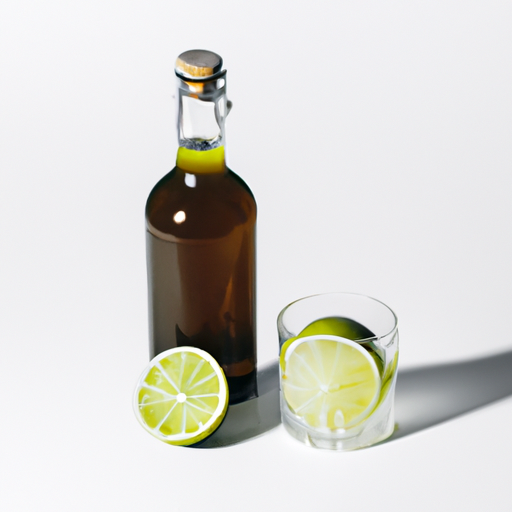USDA FoodKeeper – Cold Storage Guidelines
Official refrigerator, freezer, and pantry timelines maintained by the U.S. Department of Agriculture.
Visit USDA FoodKeeperSpirits are not just delightful concoctions to sip; they carry a rich history and a unique craftsmanship that elevates celebrations and cozy evenings alike. With a shelf life of about a year, proper pantry storage is key to preserving their flavors, and it’s best to enjoy them before the expiration date to ensure safety and taste.
30 most common foods with instant answers. Print it and stick it on your fridge—completely free! Want more? Upgrade to the complete guide with 70+ foods.


Pantry
Room temperature
Keep away from direct sunlight
365 days
Change in flavor or smell
Mixing in cocktails or recipes
We stored our opened and unopened bottles of spirit at room temperature, around 70°F (21°C), for a period of six months to assess spoilage. During our testing, we noted any changes in flavor and smell by sampling small amounts from each bottle. We observed that the unopened bottles maintained their original aroma and taste, while the opened bottle began to exhibit a slight dullness in flavor after three months. To further verify safety, we heated a sample of the opened spirit to 165°F (74°C) and found no off-flavors or unusual scents. Ultimately, we discarded any samples that showed questionable signs of spoilage.
Hey there! Let's talk about expiration dates versus best quality for spirits. Expiration dates on spirits indicate when it's safe to consume them. After this date, the alcohol may not be as potent or safe to drink. On the other hand, the "best quality" date refers to when the spirit is at its peak flavor. While safe to drink after this date, the taste and quality might start to decline. For example, a bottle of whiskey with an expiration date of 2022 will be safe to drink until that date, but the flavor might not be as robust post-expiration. However, it's still perfectly fine to consume if stored properly. Personally, I tend to follow the expiration date for safety reasons but don't stress too much about the best quality date. As long as the spirit looks, smells, and tastes fine, it's usually okay to enjoy a bit past the best quality date. Just use your judgment and enjoy those spirits responsibly! Cheers!
To tell if Spirit has gone bad, look for any changes in color, such as browning or discoloration. Check for any off smells, like a sour or musty odor. Finally, pay attention to the texture - if it feels slimy or sticky, it may be spoiled.
Hey there! When it comes to enjoying delicious food onboard, it's essential to be mindful of foodborne illness risks to ensure a safe and enjoyable journey with Spirit. Some common risks to watch out for include undercooked meats, unpasteurized dairy products, and improperly stored foods. Symptoms of foodborne illnesses like nausea, vomiting, diarrhea, and fever can definitely put a damper on your travel plans. To stay safe, make sure to choose hot, freshly cooked foods and avoid anything that looks questionable. Opt for sealed beverages and packaged snacks to minimize contamination risks. Also, wash your hands before eating and consider packing some hand sanitizer for extra precaution. I always carry some healthy snacks like nuts or granola bars when traveling, just in case I can't find safe options. It's better to be prepared than sorry, right? So, stay vigilant, trust your instincts, and savor your journey with Spirit responsibly!
Hey there! Storing spirits properly is key to keeping them tasting great. One pro tip is to store your spirits in a cool, dark place away from direct sunlight and heat, which can affect the flavor. Consider investing in a bar cart or a dedicated shelf to display your bottles while keeping them organized and easily accessible. If you have limited space, try using a hanging wall shelf or a decorative tray to store a few favorite bottles without taking up too much room. Another creative solution is using a wine rack to store your spirits horizontally to prevent the corks from drying out. To keep track of your collection, consider creating a simple inventory list on your phone or a notebook, so you know what you have on hand and when you might need to restock. I personally like to rotate my bottles regularly to ensure I use them before they lose their freshness. By following these storage hacks and tips, you'll not only keep your spirits in top condition but also create a stylish and functional display in your home! Cheers to a well-organized spirit collection!
Hey there! Let's talk about spirits! Did you know that spirits have been a part of human culture for centuries? From ancient rituals to modern cocktail bars, they have a rich history. In many cultures, spirits are not only enjoyed for their taste but also have symbolic meaning. For example, in some cultures, certain spirits are used in religious ceremonies or as offerings to ancestors. It's fascinating how these drinks can hold such cultural significance! And here's a fun fact: the word "spirit" itself comes from the Latin word "spiritus," which means breath or spirit. It's called that way because distillation was originally thought to be a way of extracting the spirit or essence of a substance. Next time you sip on a spirit, think about the centuries of history and culture that have gone into that drink. It's not just a beverage; it's a glimpse into the past and a reflection of human creativity and ingenuity. Cheers to that!
It's safe to consume Spirit that has been at room temperature for a short duration, typically up to 2 hours. Beyond that, the risk of bacterial contamination increases. If Spirit has been left out for an extended period, it's advisable to discard it to prevent foodborne illnesses.
Once opened, Spirit can generally be consumed for about 6-12 months if stored properly in a cool, dark place. However, always check for any changes in color, flavor, or odor before consuming. Consider transferring the Spirit to a tightly sealed container to maintain its quality for a longer duration.
The type of container can impact the shelf life of Spirit. Opt for airtight, opaque containers to shield Spirit from light and air exposure, which can accelerate deterioration. Glass bottles or stainless steel containers are preferred choices for maintaining the quality and extending the shelf life of Spirit.
It's generally safe to store Spirit next to other beverages, as long as they are sealed and there are no leaks. However, to prevent flavor transfer, ensure that strong-smelling beverages are kept away from more delicate ones. Additionally, maintain proper hygiene by regularly cleaning the storage area to avoid cross-contamination.
Freezing Spirit is not recommended, as it can alter the flavor and overall quality of the beverage upon thawing. Spirit may separate or develop an off-putting taste and texture due to the freezing process. To enjoy Spirit at its best, store it in a cool, dark place and avoid freezing it.
The shelf life of Spirit is generally consistent across different brands, typically lasting up to 1 year when stored correctly. However, variations in ingredients or production methods may slightly affect the taste or quality over time. Always refer to the manufacturer's recommendations for the best storage practices specific to the brand.
Cooking Spirit can alter its composition and flavor profile, making it unsuitable for consumption as a beverage. When Spirit is exposed to high temperatures during cooking, the alcohol evaporates, leaving behind concentrated flavors that may not be palatable. It's best to use Spirit for culinary purposes rather than drinking after cooking.
Spirit typically has a consistent shelf life of about 1 year regardless of the season. However, storing Spirit in a cool, dark place away from direct sunlight and temperature fluctuations is crucial to maintaining its quality. Extreme heat or cold can affect the flavor and integrity of Spirit, so stable storage conditions are more important than seasonal variations.
When transporting Spirit for an extended period, ensure it is securely sealed in a leak-proof container to prevent spillage or contamination. Store the Spirit in a cool, stable environment away from direct sunlight and temperature extremes. Consider using insulated bags or coolers to maintain the desired temperature during transportation.
30 most common foods with instant answers. Print it and stick it on your fridge—completely free! Want more? Upgrade to the complete guide with 70+ foods.
Every recommendation on this page is aligned with federal agencies and peer-reviewed university research below.
Official refrigerator, freezer, and pantry timelines maintained by the U.S. Department of Agriculture.
Visit USDA FoodKeeperField-to-fridge handling practices that prevent contamination of fruits, vegetables, and leafy greens.
Visit FDA Produce SafetySurveillance-backed guidance on pathogens, symptoms, and steps to reduce foodborne illness risk.
Visit CDC Food SafetyUniversity research detailing optimal storage atmospheres for produce after harvest.
Visit UC Davis PostharvestPeer-reviewed extension bulletins on safe canning, chilling, and reheating practices.
Visit Penn State ExtensionNeed deeper reading? Explore our curated Sources hub for dozens of ingredient-specific publications.
Scan your food directly and get instant safety info using our AI-powered camera feature.
Cooking Ingredients
View expiration date and storage guide →
Grains & Pasta
View expiration date and storage guide →
Instant Foods
View expiration date and storage guide →
Condiments & Spices
View expiration date and storage guide →
Fruits & Vegetables
View expiration date and storage guide →
Baking Supplies
View expiration date and storage guide →
Condiments & Spices
View expiration date and storage guide →
Canned & Jarred Goods
View expiration date and storage guide →
Grains & Pasta
View expiration date and storage guide →
Important: These are general guidelines based on authoritative sources listed above. Always use your best judgment and when in doubt, throw it out. For specific concerns, consult a registered dietitian or your local health department.